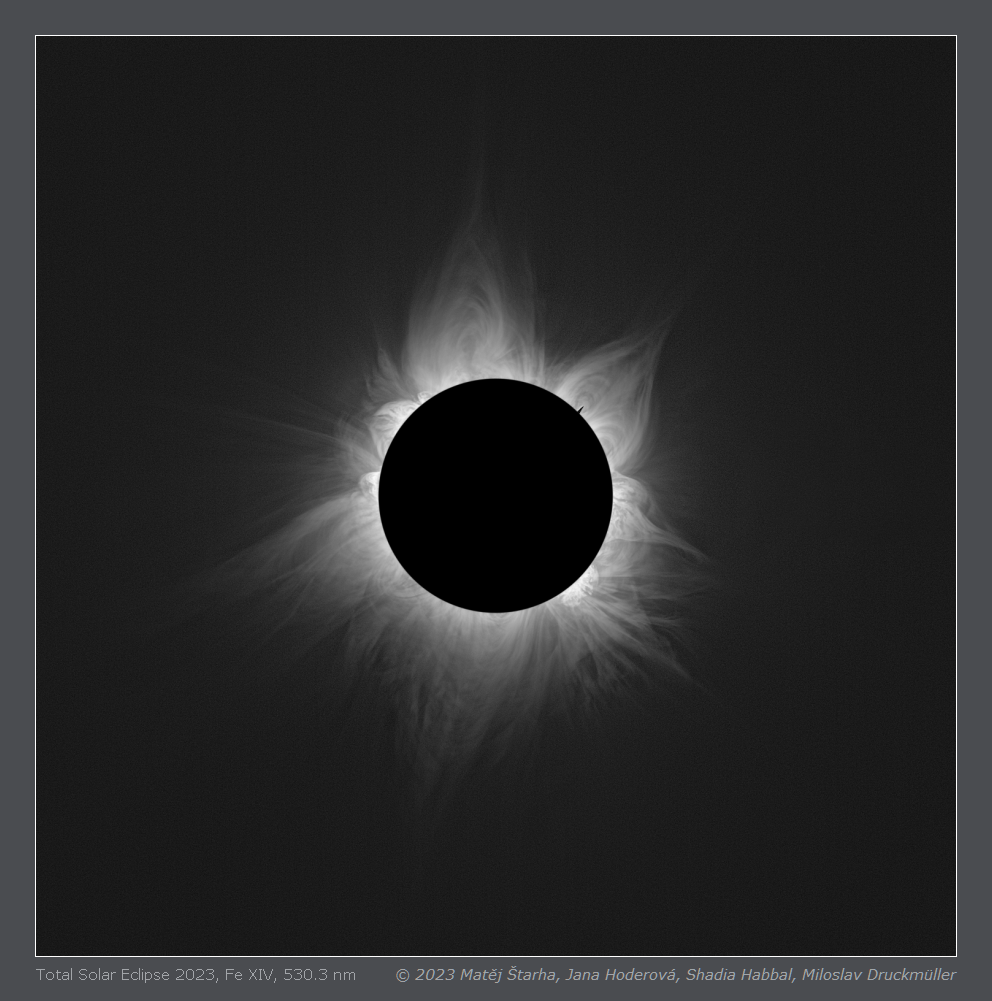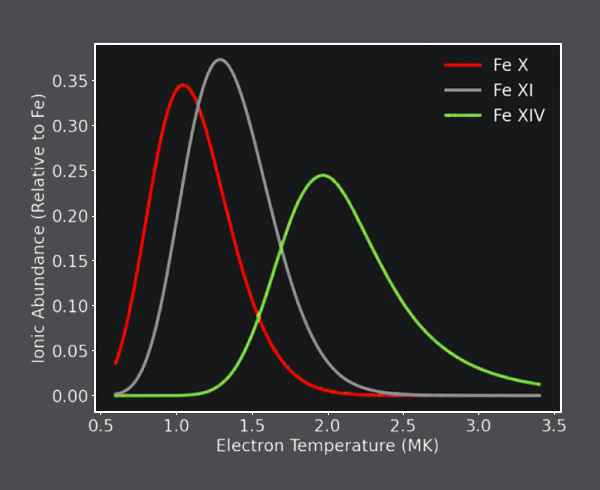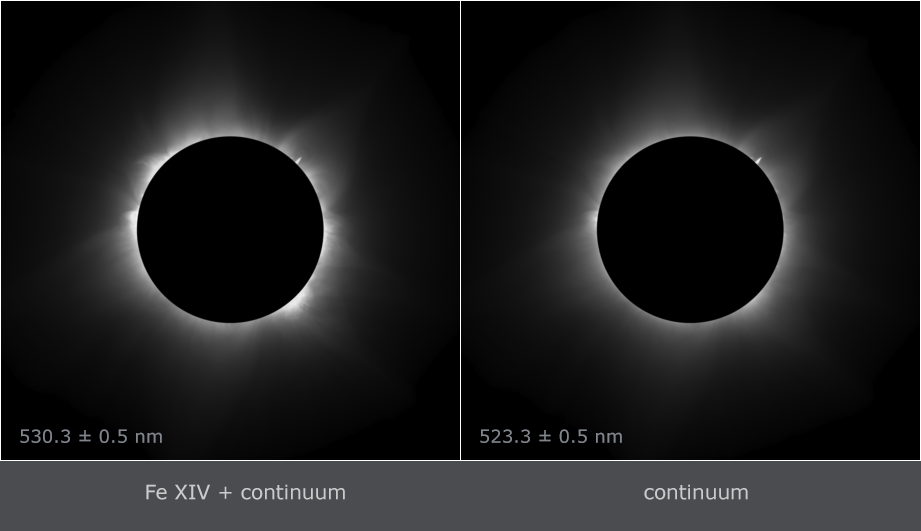
Fe XIV, 530.3 nm
Our expedition observed emission from several ions in the visible
and near IR wavelength range. The strong emission of Fe X (637.4 nm),
Fe XI (789.2 nm) and Fe XIV (530.3 nm)
enables to create high resolution images. These emission lines provide an excellent
diagnostic tool
for probing the physics of the solar corona. One of these tools is clear from the following graph.
 Even though Fe XIV is the strongest emission line in the visible part of the coronal spectrum it
is not easy to obtain an image of Fe XIV only. It is not as simple as deep sky photography of emission
nebulae where only sufficiently narrow band filter is needed to isolate the emission line. The light of
solar corona is dominated by continuum - photospheric light scattered on free electrons. The light emitted
by different atoms and ions is very weak relative to the continuum. See the following two unprocessed images.
The left one was taken through a narrow band filter (bandwidth 1 nm) with the transmission band centered on
the
Fe XIV 530.3 nm emission line. The right image was taken through a filter with the transmission band outside
the Fe XIV line in the continuum. It is clearly visible that except for the active regions in the innermost
corna the left image is highly contaminated by continuum. It is not advisable to use a filter with a narrower
band
of transmission because the emission line is thermally broadened. Hence, a narrower band filter would make
the
situation even worse. Therefore it is necessary to make a precise photometric calibration of all images and
than subtract the
continuum - the right image from the left one. You may see these two images as an
animation.
Even though Fe XIV is the strongest emission line in the visible part of the coronal spectrum it
is not easy to obtain an image of Fe XIV only. It is not as simple as deep sky photography of emission
nebulae where only sufficiently narrow band filter is needed to isolate the emission line. The light of
solar corona is dominated by continuum - photospheric light scattered on free electrons. The light emitted
by different atoms and ions is very weak relative to the continuum. See the following two unprocessed images.
The left one was taken through a narrow band filter (bandwidth 1 nm) with the transmission band centered on
the
Fe XIV 530.3 nm emission line. The right image was taken through a filter with the transmission band outside
the Fe XIV line in the continuum. It is clearly visible that except for the active regions in the innermost
corna the left image is highly contaminated by continuum. It is not advisable to use a filter with a narrower
band
of transmission because the emission line is thermally broadened. Hence, a narrower band filter would make
the
situation even worse. Therefore it is necessary to make a precise photometric calibration of all images and
than subtract the
continuum - the right image from the left one. You may see these two images as an
animation.
 It is obvious that imaging in Fe XIV at 530.3 nm through any narrow band filter without
continuum subtraction is misleading because the image is strongly dominated by continuum. If the
bandwidth of the filter is wider than about 5 nm the image is nearly identical to the broadband
white-light image taken without any filter. From the point of contamination by continuum Fe XIV
503.3 nm is the worst emission line in solar corona because its wavelength is very near to the maximum
of the solar photospheric irradiance. On the other hand Fe XIV ions are strongly excited by photospheric
light and therefore the Fe XIV emission is observable very far from the Sun.
It is obvious that imaging in Fe XIV at 530.3 nm through any narrow band filter without
continuum subtraction is misleading because the image is strongly dominated by continuum. If the
bandwidth of the filter is wider than about 5 nm the image is nearly identical to the broadband
white-light image taken without any filter. From the point of contamination by continuum Fe XIV
503.3 nm is the worst emission line in solar corona because its wavelength is very near to the maximum
of the solar photospheric irradiance. On the other hand Fe XIV ions are strongly excited by photospheric
light and therefore the Fe XIV emission is observable very far from the Sun.
The full resolution version of the Fe XIV image (2.6 arcsec/pixel) you may find
here.
Very interesting is the comparison of Fe XIV image and
Fe X image which shows a significant difference between the distribution of these ions in the solar
corona. Whereas Fe XIV ions visualize predominantly the solar magnetic field lines which are closed in
the nearest vicinity of the Sun, Fe X conversely visualizes mainly the magnetic field lines which are
opened to interplanetary space and they are closed somewhere very far from the Sun.
Click on the image or on the following reference to display the
higher resolution image version (1.9 MB, PNG format).
|
| Image | TSE_2023_Fe_XIV_Island.png |
| Date | 20. 04. 2023 |
| Time | 2nd contact 03:34:24 UT, 3rd contact 03:35:27 UT |
| Place | Island in Lowendal Islands, Australia |
| Coordinate | S 20° 38.0844', E 115° 34.3158', Alt. 4 m |
| Conditions | Clear sky, solar altitude 56.3° above horizon |
| Optics | 2× Zeiss Tele-Tessar 4/300 mm equipped with following narrow band filters:
on-band filter: Alluxa, center wavelength: 530.3 nm, bandwidth 1 nm
off-band filter: Alluxa, center wavelength: 523.3 nm, bandwidth 1 nm |
| Camera | 2× ZWO ASI1600MM Pro |
| Exposure | 0.025 s - 3.2 s |
| Processing | Composition of 74 eclipse images (37 on-band and 37 off-band) taken with two cameras. Images were calibrated by means of dark frames and flat-fields, aligned by means of phase correlation, composed by means of LDIC 6.0 software, continuum was removed from Fe XIV emission by subtracting the off-band images. The resulting image was processed using Corona 5.0 software in order to visualize coronal structures. The final processing was done using ACC 6.1 software.
Image processing by Miloslav Druckmüller |
| Software | Astro D3F 2.0, PhaseCorr 7.0, LDIC 6.0, Corona 5.0, Sofo ACC 6.1 |
| Orientation | Image must be rotated 23.3° counter-clockwise to achieve standard orientation i.e. solar North up. |
| Copyright | © 2023 Matěj Štarha, Jana Hoderová, Shadia Habbal, Miloslav Druckmüller |

|
Miloslav Druckmüller
Institute of Mathematics, Faculty of Mechanical Engineering
Brno University of Technology, Czech Republic
druckmuller@fme.vutbr.cz
|
Page last update: 27.6.2023
|
|

